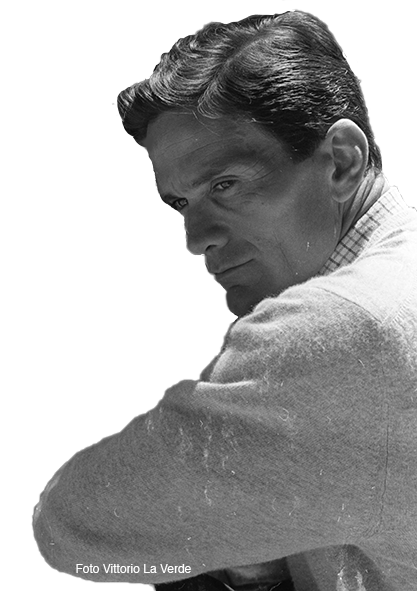Pasolini: How Sexuality and Religion influenced an Artist
3.5.2013 – http://www.leftlion.co.uk/ – Articolo originale
Broadway have a season of Pasolini film showing throughout May. Ashley Carter takes a look at how one of Italy’s greatest filmmakers was influenced by his Catholic upbringing and the conflict that arose with his sexuality.
[Broadway offre una retrospettiva sull’opera cinematografica pasoliniana lungo il mese di maggio. Ashley Carter getta uno sguardo sull’influenza dell’educazione cattolica nel lavoro di uno dei maggiori registi italiani e sul conflitto che questa generò nella sua sessualità.]
The Gospel According to Matthew
In 1975, at the age of 53, Pier Paolo Pasolini was found dying on a beach outside of Rome. He had been run over repeatedly with his own car, driven by 17-year-old male gigolo, Giuseppe Pelosi. His final finished film, 120 Days of Sodom, was released posthumously to intense criticism for its relentless presentation of sexual and scatological violence and humiliation. Barely ten years previously Pasolini, who was both gay and had an enduring affiliation with communism, made his cinematic masterpiece: The Gospel According to Matthew. Created with an entirely amateur cast it depicted the life, death and resurrection of Jesus Christ, with almost all dialogue taken directly from the New Testament.
To be homosexual in 1950s Italy was a complex struggle against the institutionalised religion of Catholicism. In 1949 Pasolini, by then an established poet and member of the Italian Communist Party, was publically outed against his will: his most intimate sexual peccadilloes revealed with his being charged with “corrupting minors and obscene acts in a public place”. The public scorn that followed, fuelled by the Catholic obsession with homosexuality, led to his expulsion from the Communist Party and self-imposed exile to Rome, whereafter his focus shifted to cinema.
Both the facts that homosexuality predates any form of organised religion and will outlast any existing deity were ignored – and for the most part still are – by a very conservative Italian society, whose convictions were resolutely grounded in the Catholic interpretation of the Bible. Those faithful who call it ‘unnatural’ are the same who don’t level such assertions at the heterosexuals who cannot conceive. The same who quoted versus such as Leviticus when condemning same-sex couples themselves ignore the same passages that prohibit the eating of shellfish; or the planting of two different crops in one field; or the use of clothes made from more than one fabric. The formidable voice for antitheism, Christopher Hitchens, contends that this Catholic fixation comes from a “repressed desire to participate”, citing the example from King Lear; “the policeman who lashes the whore has a hot need for the very offense for which he plies the lash.” The reason for the early Catholic obsession with homosexuality is, and will forever remain, unclear.
It was this repressed society that inspired Pasolini artistically: his hatred of conformity was present in every poem, letter, script, article, speech and film he created. Armado Maggi wrote that Pasolini claimed; “conformity identifies with social and cultural oppression, intellectual death and violence”. There was no greater example of this compliance than the relationship, gorged on corruption and control, between church and state. So why create a film of such majesty telling the story of the foundation of the faith that made Pasolini a social outcast, labelled him a sexual deviant and severely repressed the society he desperately wanted to change?
Salo, or The 120 Days of Sodom
One feasible reason lies within Rocky O’Donovan’s essay, Reclaiming Sodom, in which the biblical myth of Sodom and its links to modern homosexuality are explained in relation to a reclaimed identity within the gay community. Pasolini’s entire life would have been saturated with Catholicism: communion, confession, biblical studies and regular prayer would have been the backbone of his existence. With his only exposure to homosexuality being the tales of Sodom and Gomorrah, coupled with his inherent dislike of conformity, his mindset could well have been aligned to the embracing of the alien. He frequently referred to himself as a “creative against nature” early in his life. This undeniable link between his sexuality, along with his exposure to the misguided link between homosexuality and the end of society, presented Pasolini with a perfect platform for which to express himself creatively. The “sodomite”, as O’Donovan puts it, presented Pasolini with a dual role in the social order. Firstly, it “manifests and speaks of the fall of time, its very existence proves that we are all living at the end of days”, and secondly, with similarity to an Old Testament prophet, “the sodomite recognises the signs of the end of times, and announces it.”
As a result of this mindset, with its measured embracing of religion, Pasolini was able to create within a ready-made framework that circumvented both persecution and conformity. Thus his desire to recreate the source of this context as accurately as possible is comprehensible.
Politically too, Pasolini found inspiration in religion. His representation of Jesus in The Gospel According to Matthew is as an archetypal revolutionary leader: obdurate with a complete intolerance of concession or compromise. Pasolini’s Marxist beliefs found a closer alignment with the Jesus he found directly in the Bible than the figure that was presented to him during his young life. A Christ-like figure became a frequently present figure in his work; the self-sacrificial young hero, stubborn and unmoving in his virtues. This more romanticised view of Pasolini’s influences relies on the semblance of some goodwill still remaining in his childhood religion, evidence of which he was keen to provide, saying; “I may be an unbeliever, but I am an unbeliever who has nostalgia for belief”. His contemporary filmmaker Andrei Tarkovsky seemingly agreed with this method, saying of the film; “I like it precisely because its director did not succumb to the temptation of interpreting the Bible. Pasolini did not set himself this task; he just left the thing in the form in which it was born. Many feel that the image of a militant, cruel Christ was made up by the author of the film. Not true – read the Gospels and you will see that this Jesus a cruel, cantankerous, irreconcilable man.”
What then created such a dynamic change in his creative output between the release of The Gospel According to Matthew and 120 Days of Sodom and his death barely ten years later? The answer lies in the significant change in the social attitude of sixties and seventies Italian culture. The taboos surrounding sexuality and sexual repression were hastily being lifted. A fresh, liberated society was emerging from the ashes of generation after generation of social and religious authoritarianism. In one initiation, the world viewed sexuality in a completely different fashion; no longer was homosexuality viewed solely as a social disease. For the majority of those previously sexually reticent, this breakthrough was positively life changing. But for Pasolini, whose very existence had been built upon being a social outcast and, as Armado Maggi states; “a prophet of doom”, the opposite was true.
Pier Paolo Pasolini
In his essay, Abjuration of The Trilogy of Life, Pasolini contends that towards the end of the sixties Italy underwent a remarkable transformation, which he defines as the triumph of “the unreality of mass culture”. He asserts that the new sexual freedom caused a “trauma” to those individuals who, like him, lead a “private” sexual life. His role as the biblical sodomite, prophet of doom and social outcast was now irrelevant, leading to the dramatic shift in his creative content, fuelled by a deeply conflicted sexual identity.
Later in the same essay, Pasolini states; “the last bulwark of reality seemed to be the innocent bodies with the archaic and dark violence of their sexual organs”. This “dark violence” was to become the cornerstone of the rest of his cinematic achievement, as sexual brutality and degradation became the focus of his work. Any who have seen 120 Days of Sodom will know, it is not the work of a contented mind. It reveals an inner despair almost beyond comprehension. Pasolini’s exploration of the human capacity for cruelty and sexual sadism bordered on unimaginable. The focus of his attention had been irreversibly modified from the spiritual to the physical.
Many gay filmmakers have explored the initial experiences of their homosexuality during their Catholic upbringing. Terence Davis, in his haunting narration for Of Time and The City, recalls confusing trips to local boxing matches, reminiscing about the confusing intensity of feeling while watching the pugilists in combat. But none portray the condemnation and contested carnal existence as deeply as Pasolini, his striking body of work displays the remarkably destructive role religion can play in the mind of an artist. As both muse and critic, comfort and tormenter, it creates such immeasurable distress on the mind of one exposed to it from the earliest possible age. Under such duress, very few healthy outcomes are possible. Walter Wink, in his book Homosexuality and Christian Faith contends that when dealing with homosexuality in a sexually repressed society; “When you can’t deny it, explain it, or fix it, the only thing left to do is mourn it”. Ironically for Pasolini, as with many true artists, the opposite was true, and it wasn’t until the comfort of his restrictive society was gone that his inner torment truly began.
Now, almost forty years after his death, Pasolini’s legacy is that of a major figure in European literature and art. Very few twentieth century artists achieved success in such a diverse collection of fields, despite his position as a figure of such fierce controversy. His murderer, after serving thirty years in jail, remarkably and suddenly retracted his confession. Extortion and political motives have both been put forward as possible reasons for his killing, though nothing has ever been proved. His fixation with religion followed him until his final moments, according to close friend Giuseppe Zigaina, who denies that it was any of the suspected motives, instead claiming that he; “carefully planned and acted out his death, a self-sacrifice in a sort of Christ-like ritual.”
The mark Pasolini left on the world of poetic filmmaking is undeniable, both as a figure of social freedom and of sexual liberation. His confused sexual identity formed the basis of the undermining of the institution that shaped his entire life. He perfectly bridged the gap between the neo-realists like Fellini and the young, vibrancy of latter filmmakers such as Bertolucci. The way in which he presented society was as unforgiving as his portrayal of sexuality was brutal. It is for this candour and independence that Pier Paolo Pasolini deserves his reputation as one of the most enigmatic masters of European filmmaking.
[idea]
Broadway’s Pasolini season runs throughout May:
The Gospel According to Matthew, Sunday 5 May, 12.45pm
The Canterbury Tales, Monday 13 May, 5.15pm
Salo, or The 120 Days of Sodom, Sunday 26 May, 1pm
Theorem, Monday 27 May, 1.45pm
Broadway – Cinema
14 – 18 Broad Street – Nottingham – England
NG1 3AL 0115 9526 611
info@broadway.org.uk
http://www.broadway.org.uk/
[/idea]



